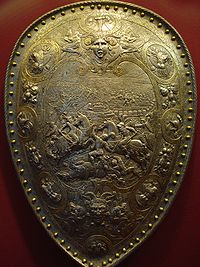
Étienne Delaune
Encyclopedia

Engraving
Engraving is the practice of incising a design on to a hard, usually flat surface, by cutting grooves into it. The result may be a decorated object in itself, as when silver, gold, steel, or glass are engraved, or may provide an intaglio printing plate, of copper or another metal, for printing...
, was born in Paris, or more probably at Orléans
Orléans
-Prehistory and Roman:Cenabum was a Gallic stronghold, one of the principal towns of the Carnutes tribe where the Druids held their annual assembly. It was conquered and destroyed by Julius Caesar in 52 BC, then rebuilt under the Roman Empire...
, in 1518. He commenced bis
career as an engraver of medals, and is said to have been helped by Benvenuto Cellini
Benvenuto Cellini
Benvenuto Cellini was an Italian goldsmith, sculptor, painter, soldier and musician, who also wrote a famous autobiography. He was one of the most important artists of Mannerism.-Youth:...
, who was at that time living in Paris. He afterwards engraved many prints after Raphael
Raphael
Raffaello Sanzio da Urbino , better known simply as Raphael, was an Italian painter and architect of the High Renaissance. His work is admired for its clarity of form and ease of composition and for its visual achievement of the Neoplatonic ideal of human grandeur...
, and the Italian masters of Fontainebleau, and still more after the designs of his son Jean, with whom he passed the greater part of his life at Strassburg
Strasbourg
Strasbourg is the capital and principal city of the Alsace region in eastern France and is the official seat of the European Parliament. Located close to the border with Germany, it is the capital of the Bas-Rhin département. The city and the region of Alsace are historically German-speaking,...
. His style was formed upon that of the Little Masters
Little Masters
The Little Masters , were a group of German printmakers who worked in the first half of the 16th century, primarily in engraving. They specialized in very small finely detailed prints, some no larger than a postage stamp...
of Germany. He died at Strassburg in 1595.
Étienne Delaune was one of the most famous designers of goldsmith's work of his time. There are six of his designs in the Louvre
Louvre
The Musée du Louvre – in English, the Louvre Museum or simply the Louvre – is one of the world's largest museums, the most visited art museum in the world and a historic monument. A central landmark of Paris, it is located on the Right Bank of the Seine in the 1st arrondissement...
; two of them are for circular dishes representing the Histories of Moses and of Samson. His prints, which are generally small, are very numerous; they are executed entirely with the graver
Burin
Burin from the French burin meaning "cold chisel" has two specialised meanings for types of tools in English, one meaning a steel cutting tool which is the essential tool of engraving, and the other, in archaeology, meaning a special type of lithic flake with a chisel-like edge which was probably...
, with great dexterity of handling, and are very highly finished. He copied some of the prints of Marc Antonio
Marcantonio Raimondi
Marcantonio Raimondi, also simply Marcantonio, was an Italian engraver, known for being the first important printmaker whose body of work consists mainly of prints copying paintings. He is therefore a key figure in the rise of the reproductive print...
with success. He usually marked his prints with the initial of his Christian name, S., or S. F., or S. fecit, but sometimes Stephanus, fecit. His works are described in Robert-Dumesnil's 'Peintre-Graveur,' vol. ix. The following are the principal:
- A set of thirty Subjects from the Old Testament.
- A set of eighteen Mythological Subjects; oval, very small.
- The Twelve Months of the Year; circular.
- Jupiter, Neptune, Mercury, and Ceres; four circular plates.
- Four Subjects from Ancient History ; oval.
- The Four Monarchies; oval.
- Four plates of Rural Occupations; oval.
- The Three Graces.
- David and Goliath; after Marc Antonio.
- The Murder of the Innocents; after the same.
- The Martyrdom of St. Felicitas; after the same.
- The Rape of Helen; after the same.
- The Brazen Serpent; after Jean CousinJean Cousin the ElderJean Cousin was a French painter, sculptor, etcher, engraver, and geometrician. He is known as "Jean Cousin the Elder" to distinguish him from his son Jean Cousin the Younger, also an artist.-Career:...
. This is one of his largest prints.

